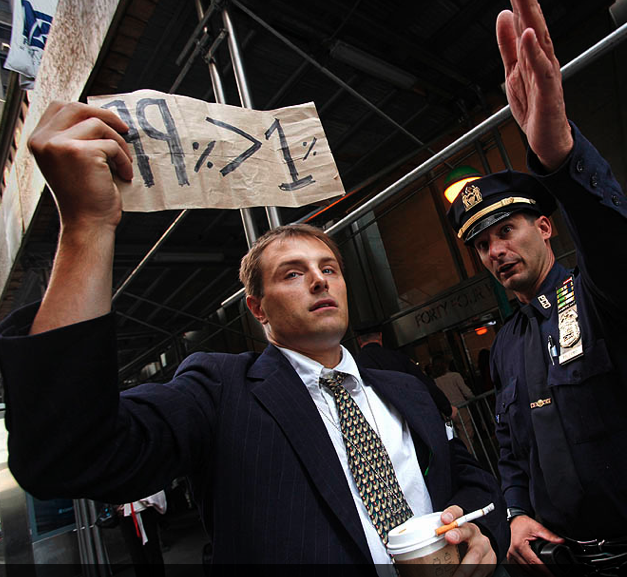
Image Credit: Screenshot capture of photograph by Carolyn Cole / Los Angeles Times
The photograph above was featured this week in The L.A. Times' coverage of the Occupy Wall Steet movement's one-year anniversary. The caption provided beneath the photo states, "A man wanting to join the Occupy protesters on Monday is told to leave Wall Street." The image gives pause, not because a policeman is pictured confronting a protester, but because the man's ethos seems incongruous with that of the anarchist-inspired OWS movement. My recollection of the "Occupied" zone in downtown Austin last winter calls to mind the image of a different kind of a protester, one who looks as committed to battling the elements as he is to changing the status quo. This unidentified man, however, does not look prepared for the scene of mayhem he is allegedly trying to enter. With a cigarette balanced precariously atop his coffee cup, he looks like he's just popped down from the 20th floor to grab some more uppers. It's amusing (or disheartening, depending on your outlook) to imagine him scrawling "99%>1%" on a scrap of paper before venturing into the mob that separates him from the nearest Starbucks. But this is pure speculation. It's equally likely that the man in the photograph is an overworked reporter, or an analyst who has thousands of dollars of debt from student loans. Perhaps he was walking by the OWS demonstration, got inspired, and decided to join on a whim. Either way, the photographer caught him looking weary, unimpassioned, and in a moment of half-hearted negotiation with the police, which is why this photo provides a useful illustration of the phenomenon known as slacktivism.
Recent comments
2 years 29 weeks ago
2 years 44 weeks ago
2 years 44 weeks ago
2 years 50 weeks ago
3 years 4 weeks ago
3 years 4 weeks ago
3 years 4 weeks ago
3 years 6 weeks ago
3 years 6 weeks ago
3 years 6 weeks ago